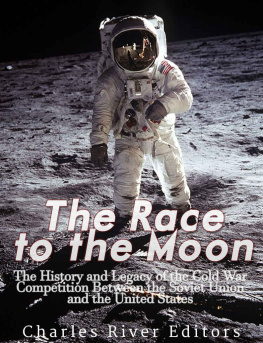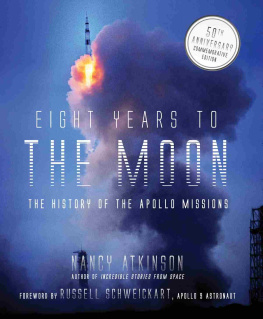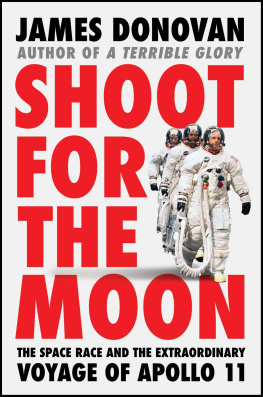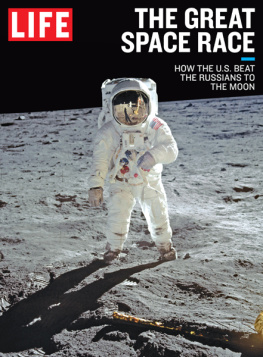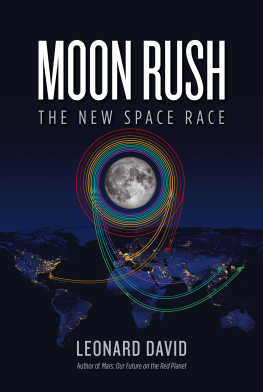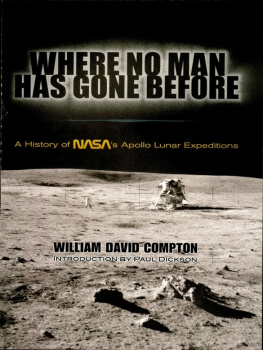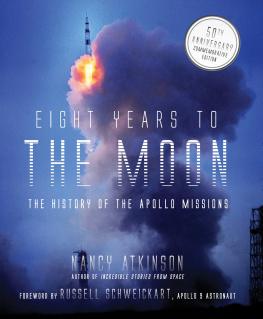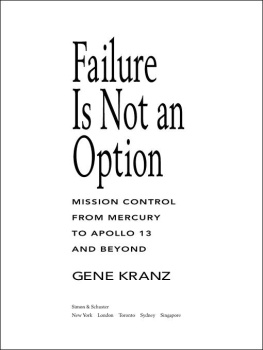The Space Race
The Thrilling History of NASAs Race to the Moon, from Project Mercury to Apollo 11 and Beyond
Get a Free Book
Get John Hamiltons Wild Bill Hickok biography FOR FREE. Sign up for the no-spam newsletter and get Wild Bill Hickok and other exclusive content, all for free.
Details can be found at the end of The Space Race.
Contents
Missiles and Spy Satellites
Chapter 1
The Space Race
After World War II ended in 1945, two superpowers emerged: the United States and the Soviet Union. These two allies combined forces during the war to defeat the worldwide threat of Nazi Germany, Japan, and Italy. After the war, however, their partnership quickly fell apart.
Each side wanted to show the world that its system of government was best. The conquest of space was a perfect way to show off their superior technology. At first, the military drove the space race. Each side worked to build better rockets and missiles that could strike targets across the oceans. Spy satellites were sent into orbit so suspicious generals and politicians could keep an eye on the enemy.
With time, another goal arose. Both the United States and the Soviet Union vowed to put people into space. The ultimate goal: to land someone on the Moon.
Apollo 11 launches on July 16, 1969. Astronauts Neil Armstrong, Buzz Aldrin, and Michael Collins sit atop the powerful Saturn V rocket, heading toward the Moon.
Chapter 2
Early Rockets
Modern rockets are powerful enough to send spacecraft billions of miles beyond the edge of our Solar System. The history of the Space Race, however, began hundreds of years ago, when rockets were simple toys.
Around 400 bc , a Greek man named Archytas lived in the southern city of Tarentum, Italy. He amused people by making a wooden pigeon fly. Archytas partly filled the wooden bird with water and then heated it over a fire. The water turned to steam and shot out of a hole in the pigeon. The toy was then thrust in the opposite direction.
Three hundred years after Archytas, a Greek named Hero, from the city of Alexandria, invented another steam-powered curiosity. He mounted a sphere above a kettle of water. A fire under the kettle turned the water to steam. The steam forcefully escaped through two L-shaped tubes. This caused the sphere to rotate rapidly, to the amazement of everyone who saw it.
Nobody really knows when or where true rockets were invented. It probably happened somewhere in China during the first century ad . Chinese chemists experimented with early forms of gunpowder and used it to make fireworks. They made fireworks by putting the explosives in bamboo tubes. When set on fire, the escaping gasses from the gunpowder caused the tubes to fly through the air. The Chinese also attached the bamboo tubes to arrows. These solid-fuel fire arrows flew straighter than the bamboo rockets alone.
The first known use of rockets in warfare happened in 1232 at the Battle of Kai-Ken. The Chinese used masses of fire arrows to kill and frighten invaders from Mongolia.
Chapter 3
How Rockets Work
Think of a rocket as if it were a balloon. First, you inflate it with air. When you squeeze shut the neck, or nozzle, there is a pressure inside the balloon. The pressure is higher than the air outside. The balloon stays where it is because the air presses equally against the inside walls. The pressure is the same in every direction.
When you let go of the nozzle, you create an imbalance in the balloon. The internal pressure at the front of the balloon is now greater than the pressure at the back. The air shoots out of the hole, and the balloon is thrust forward. This shows physicist Sir Isaac Newtons third law of motion: for every action in nature, there is an equal and opposite reaction.
Modern rockets use the same basic science as the balloon example. One big difference is that rockets get their thrust by burning fuel, such as liquid hydrogen. In order to burn something, you need oxygen. Normal jet engines get their oxygen from the air they fly through. Rockets can work in the vacuum of space because they carry their own oxygen (an oxidizer), such as super-cooled liquid oxygen. The fuel and oxidizer are mixed together and burned in a combustion chamber at the back of the rocket. The hot, pressurized gas spews out of the engine. Following Newtons third law of motion, the rocket then moves forward in the opposite direction.
Chapter 4
Rocket Pioneers
In 1865, French novelist Jules Verne (1801-1899) published the science fiction classic From the Earth to the Moon. Three adventurers climb inside a spacecraft shaped like a bullet and are shot out of an enormous cannon toward the Moon. Their story of exploration fired the publics imagination. Many wondered if rockets could be made that would really take astronauts into space.
One of those dreamers was a Russian schoolteacher named Konstantin Tsiolkovsky (1857-1935). He was a self-taught physicist and mathematician. In 1903, he published a scientific paper called The Exploration of Cosmic Space by Means of Reaction Devices. At a time when cars and airplanes had just been invented, Tsiolkovsky (Sil-kof-skee) correctly showed how rockets could be used to travel in space. He also described multistage rockets, air locks, and rockets propelled by liquid oxygen and hydrogen. Many of his ideas are used in spacecraft today.
Another early rocket scientist was Romanian-born Hermann Oberth (1894-1989). In 1923, he published The Rocket into Planetary Space. He moved to Germany at age 18 and lived there the rest of his life. His work showed how powerful, multistage rockets could escape Earths gravity.
Robert Goddard
Along with Tsiolkovsky and Oberth, American physicist Robert Goddard (1882-1945) is known today as one of the three fathers of modern rocketry. In 1926, he became the first person to successfully build and test a rocket using liquid fuel. He proved that rockets can work in the airless vacuum of space. He also invented ways to steer rockets in flight, and made pumps for rocket fuel. In honor of his pioneering work, NASA named Marylands Goddard Space Flight Center after him.
Chapter 5
The V-2 Missile
By the 1930s, many nations realized that rockets could be powerful weapons. Scientists worked to find ways to invent long-range missiles that could carry explosives and fly automatically.
One of the most terrifying weapons of World War II (1939-1945) was the German V-2 missile. First flown by the Nazis in 1942, the V-2 carried 2,000 pounds (907 kg) of explosives at targets about 200 miles (322 km) away. Using a potent mix of ethyl alcohol and liquid oxygen fuel, the V-2 became the first man-made object to reach space.


